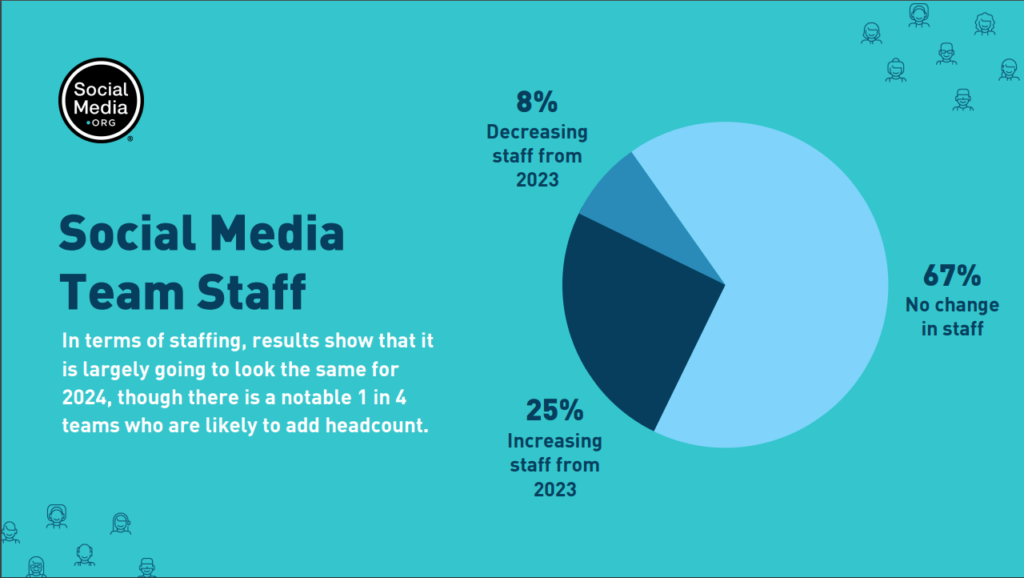Key takeaways:
- SocialMedia.org’s report found that most responding social media leaders reported holding onto headcount in 2024, with some actually adding staff.
- Whether relying primarily on agency or in-house support, it’s essential to make the most of your resources by focusing on the most effective content and revamping existing content.
- Social media is an evolving space, so it’s recommended that you adjust your team structure to account for changing trends and best practices. One social media leader suggested doing this every three to five years.
For many enterprise social media leaders, the perfect team structure is like a unicorn — we’re all hopeful it exists, but doubtful we’ll ever find it.
Still, large enterprises need to ensure their social teams are aptly structured for the future, particularly amid economic rife, organizational change, and resource constraints.
With 2023 nearly in the rearview, now is the time to evaluate how your current team aligns with your enterprise’s evolving 2024 goals.
To help you on this journey, we gathered insights from SocialMedia.org members on the best practices for creating an effective team structure.
Most Major Companies are Holding onto Headcount in 2024
Arguably, 2023 was a relatively sobering year for many enterprises, as major U.S. companies in tech, media, finance, retail, and more slashed staff.
However, SocialMedia.org’s 2024 State of Enterprise Social Media report found that one in four teams were likely to increase headcount next year.
The report, which surveyed 166 senior social media leaders, stated that 67% of respondents were anticipating no change in headcount, but a sizeable minority — 25% — will increase staff from 2023.

Making the Most of Your Agency and In-House Support By Revamping Content
In a confidential discussion with SocialMedia.org members, many agreed they’re still working to achieve true cohesion, as some important aspects of social media continue to live with another team — most often, paid media and social listening.
Working with in-house creatives who report elsewhere is still common and, for the most part, is a structure that still works for many members.
During a recent panel discussion on 2024 planning, one audience member asked panelists how they work with outside agencies to ideate and create organic content.
Kristi Daraban, Associate Vice President of Social Media at Nationwide, said her team handles almost everything in-house but leverages agency support primarily for influencer marketing and an occasional TikTok video.
“Everything else is handled by either our in-house creative team or my team, who have become these hybrid creative slash social media managers,” Kristi said.
In contrast, Carolyn Cohen, Senior Marketing Manager at H&R Block, said between 60% and 70% of their content comes from agency and production partners. Additionally, they tap influencers as a creative source.
Sourcing content from various entities has its benefits, but Carolyn also highlighted the challenges related to tracking metrics, deciding who is the best fit for which content, and getting the budget and timing right.
I think the moral of the story between everybody here is that whether it’s in-house teams or agency teams, there are challenges no matter what. You’re going to have to be able to sort through the best way to build up the content that’s needed as you go.
Carolyn Cohen, H&R Block
Regardless of whether you’re doing more internally or externally, it’s essential that you make the most of your resources.
James LaCorte, Social Media Manager at Blue Cross Blue Shield of North Carolina, shared how his team gets creative to maximize the agency support they do have.
“We may use various assets that might have been created by an agency or by the marketing department or someone else, and then recreate, reuse, and revise them — freshen them up so they fit our organic channel,” James shared.
Adjusting Your Team Structure Every 3 to 5 Years to Account for Evolving Trends
It’s no secret that the social media space is ever-changing, and as a result, social media leaders arguably need to evaluate and adjust their teams more frequently than other business units.
In a confidential discussion, SocialMedia.org members suggested re-assessing your structure every three to five years to ensure roles keep up with the changing social landscape and evolving business needs.
Members also discussed the need to reorganize your team structure for evolving social channels, particularly for teams with smaller headcounts responsible for managing all content creation.
For example, during the panel, Kristi mentioned that her team is slightly shifting away from X (formerly Twitter) as organic content is no longer performing as well as it used to.
“We’re really thinking about how else we can get content on other platforms,” Kristi said. “We did launch TikTok this year, which was a big lift for a regulated brand, but we’re excited about the growth there,”
Back in October, the company’s jingle made the rounds in TikTok in a viral “Nationwide Is on Your Side” challenge.
“We’ve been really excited to be able to capitalize on that and see the growth that maybe otherwise wouldn’t have happened,” Kristi said.
@nationwide
🚨 We found her!! 🚨 @iluhericacampbell #nationwide
♬ original sound – Nationwide
Benchmarking to Make the Case for Your Team
Social media leaders are often faced with the challenge of adding headcount to their teams to expand their programs and advance their strategies.
When SocialMedia.org Board Chair Mike Disser, Social Media and Customer Experience Manager at Nissan, was looking for support to gain more resources for his social media team, he went to his peers in SocialMedia.org to learn how to make the case for increased team size.
Using our confidential online member hub, Mike reached out to the community to ask for input on how to structure his team and secure buy-in from his senior management for more headcount.
Within a couple of days, several social media leaders at the world’s largest brands provided Mike with information on how their teams are structured and shared insights on how to streamline his team’s duties.
Mike said he received so much feedback from his peers and took the information he gained to his senior leadership team and successfully made a proposal that resulted in his team growing from eight to 13.
“It’s a direct result of the community sharing information and us being able to take that information and tell the story of why we need more people,” Mike said.
If you lead social media at a large company, you can apply to gain access to peer insights, benchmark your strategy, and advance your goals.


